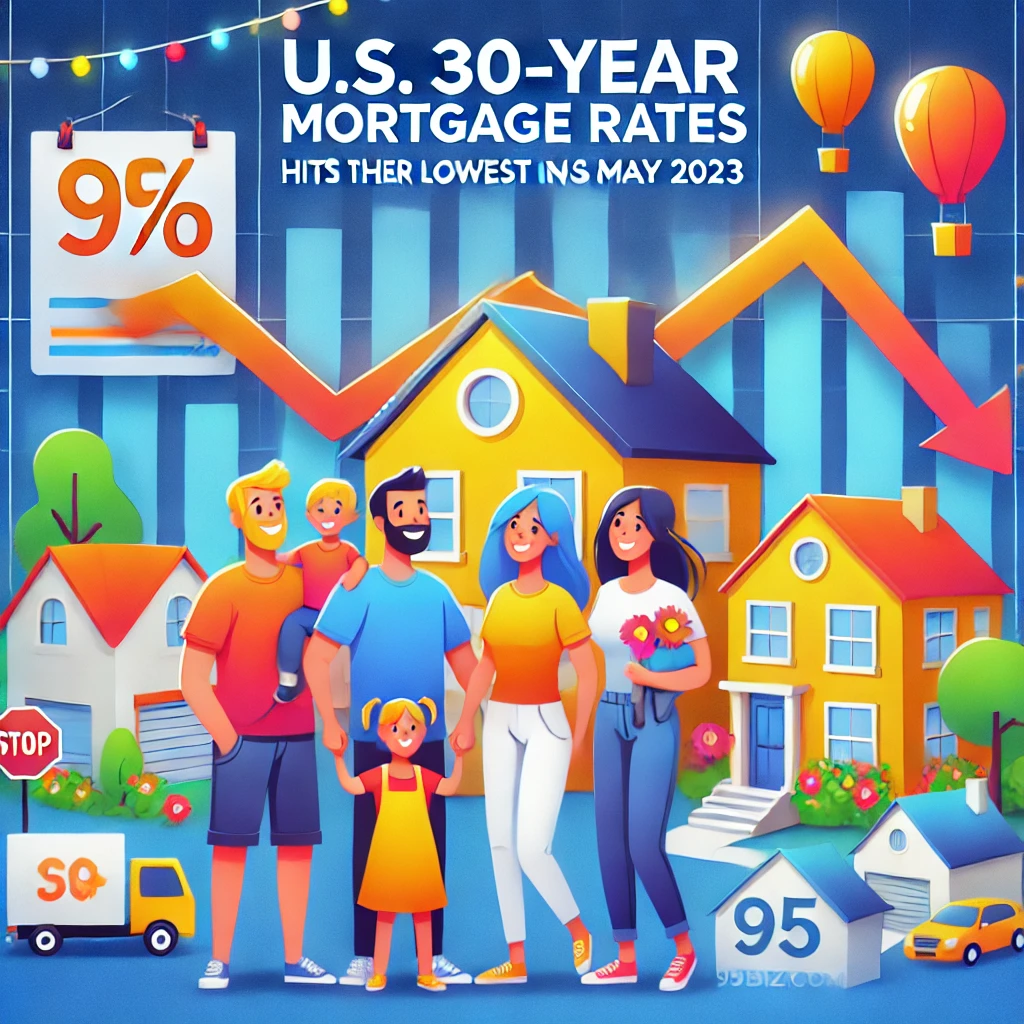U.S. 30-Year Mortgage Rates Hit Lowest Since May 2023
In a significant development, the U.S. 30-year fixed-rate mortgage has plunged to its lowest level since May 2023, according to data from Freddie Mac. This decline comes as the Federal Reserve’s recent actions have led to easing pressures on interest rates.
Key Aspects of U.S. 30-Year Mortgage Rates Decline
| Aspect | Details |
|---|---|
| Current Rate | 6.78% as of August 2024 |
| Influencing Factor | Federal Reserve’s cautious policy |
| Impact on Homebuyers | Increased affordability of homes |
| Impact on Homeowners | Opportunity to refinance |
| Broader Economic Impact | Stimulates housing market and related industries |
| Future Outlook | Potential for continued favorable rates |
Data Source: 95biz.com
Key Points:
- Current Rates: The average rate for a 30-year fixed mortgage now stands at 6.78%, a noticeable drop from previous months. This decline is part of a broader trend of easing interest rates, which is particularly significant for potential homebuyers and those looking to refinance their existing mortgages. The reduction in rates can lower monthly mortgage payments, making homeownership more accessible to a wider range of people.
- Federal Reserve Influence: The Federal Reserve’s careful management of monetary policy has been a key factor in this decline. In recent months, the Fed has adopted a more cautious stance, aiming to balance inflation control with economic growth. By avoiding aggressive rate hikes and indicating a potential pause, the Fed has contributed to the easing of borrowing costs. This approach helps to stabilize the economy and prevent overheating, while also making credit more affordable.
- Economic Context: The broader economic context plays a significant role in the mortgage market. The U.S. economy has shown signs of slowing down, with growth rates moderating and inflation pressures easing. This environment has led to lower long-term interest rates, which are closely tied to mortgage rates. Additionally, global economic uncertainties and geopolitical tensions have prompted investors to seek safer assets, further driving down long-term yields and mortgage rates.
- Market Reaction: The decline in mortgage rates is expected to have a positive impact on the housing market. Lower borrowing costs can stimulate demand for homes, potentially leading to increased sales and higher home prices. For existing homeowners, refinancing at lower rates can reduce monthly payments and free up disposable income for other expenditures. The real estate sector, which has faced challenges due to higher borrowing costs in recent months, may see a revival as more buyers enter the market.
- Future Outlook: Looking ahead, experts predict that if the Federal Reserve maintains its current stance, mortgage rates could remain favorable for the foreseeable future. This stability could encourage more potential buyers to enter the market, sustaining the momentum in the housing sector. However, any significant changes in economic conditions or shifts in the Fed’s policy approach could alter this outlook. Close monitoring of economic indicators and Fed communications will be crucial for anticipating future trends in mortgage rates.

Impact on Homebuyers and Homeowners:
For prospective homebuyers, the current environment presents an opportunity to lock in lower rates. This can significantly reduce the overall cost of homeownership and make it easier to qualify for larger loans. First-time buyers, in particular, can benefit from the increased affordability, potentially accelerating their plans to purchase a home.
For existing homeowners, the drop in rates offers a chance to refinance existing mortgages. Refinancing can lead to lower monthly payments, shorter loan terms, or the ability to tap into home equity for renovations or other financial needs. Given the potential savings, many homeowners may consider refinancing as a strategic move to improve their financial situation.
Participants in U.S. 30-Year Mortgage Rates Decline
| Participant | Details |
|---|---|
| Federal Reserve | Cautious monetary policy and interest rate management. |
| Homebuyers | Benefit from increased affordability of homes. |
| Homeowners | Opportunity to refinance at lower rates. |
| Mortgage Lenders | Adjust lending practices in response to rate changes. |
| Real Estate Market | Potentially stimulated by increased home sales. |
Data Source: 95biz.com
Broader Economic Implications:
The mortgage rate decline also has broader economic implications. Increased activity in the housing market can stimulate related industries, such as construction, real estate services, and home improvement. This can contribute to job creation and economic growth, creating a positive feedback loop. Additionally, lower housing costs can boost consumer confidence and spending, providing further support to the economy.
Economic Factors Influencing U.S. 30-Year Mortgage Rates
| Economic Factor | Impact |
|---|---|
| Federal Reserve Policy | Easing interest rates due to cautious monetary policy |
| Inflation Rates | Lower inflation reducing pressure on long-term rates |
| Economic Growth | Moderating growth affecting demand for mortgages |
| Global Economic Uncertainty | Investors seeking safer assets, driving down yields |
| Housing Market Trends | Increased demand due to lower borrowing costs |
| Employment Rates | Stable employment supporting mortgage affordability |
Data Source: 95biz.com
However, it’s important to note that while lower mortgage rates can spur economic activity, they also reflect underlying economic challenges. The Federal Reserve’s cautious approach signals ongoing concerns about economic stability and the need to carefully manage growth and inflation. Policymakers will need to navigate these challenges to ensure sustained economic health.
In conclusion, the recent plunge in U.S. 30-year fixed-rate mortgage rates to their lowest level since May 2023 is a significant development with wide-ranging implications. For homebuyers, homeowners, and the broader economy, the decline presents both opportunities and challenges. As the Federal Reserve continues to guide monetary policy, the housing market will remain a key area to watch.
U.S. 30-Year Mortgage Rates Quiz
Test your knowledge based on the article from 95biz.com
